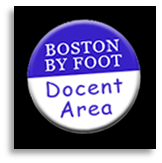 I don’t like being late and I hate having to rush or do anything at the last minute. It’s just too easy to make mistakes or do something stupid. So, with my first training class to be a Boston By Foot docent coming up next month, I have delved into their advance reading list.
I don’t like being late and I hate having to rush or do anything at the last minute. It’s just too easy to make mistakes or do something stupid. So, with my first training class to be a Boston By Foot docent coming up next month, I have delved into their advance reading list.First, I tackled “Identifying American Architecture (A pictorial guide to styles and terms, 1600—1945)” by John J.G. Blumenson, only to discover that it’s really a reference book. There are two pages per style with lots of annotated photos. It’s a good way to see what a particular form or detail looks like, although seldom close up, but you can’t read it from cover to cover.
 Next, I opened “Houses of Boston’s Back Bay (An architectural history 1840—1917)” by Bainbridge Bunting. (I thought that was a great Brahmin name but the late BB was actually from Kansas City.) This book is much better with chapters on the growth of Boston, the filling of the Back Bay, maps of the new Boston overlaying the outlines of the colonial city, and lots of pictures of individual houses. It is filled with information—so filled that the text is very dense. The frequency of pictures helps but reading it is like making a meal out of fruitcake. I just can’t do it for very long.
Next, I opened “Houses of Boston’s Back Bay (An architectural history 1840—1917)” by Bainbridge Bunting. (I thought that was a great Brahmin name but the late BB was actually from Kansas City.) This book is much better with chapters on the growth of Boston, the filling of the Back Bay, maps of the new Boston overlaying the outlines of the colonial city, and lots of pictures of individual houses. It is filled with information—so filled that the text is very dense. The frequency of pictures helps but reading it is like making a meal out of fruitcake. I just can’t do it for very long.A Changed Perspective
In the process, however, I have noticed an interesting phenomenon. The way I see buildings—just driving around or running errands—has changed. Where I used to see “an apartment building” or maybe “a red-brick apartment building” I now notice details and forms that just never registered before—probably because I didn’t know what they were.
Learning those terms has been a process. When I started I knew what a mansard roof and a muntin are (great @Scrabble word). But what’s dentil? A string course? A cornice? An entablature? To find out, I searched the web for glossaries of architectural terms and found quite a few, some more useful than others.
One dictionary of terms from the New York City Landmarks Preservation Commission is quite detailed but written for professionals. It defines an entablature, for example, as “A major horizontal member carried by a column(s) or pilaster(s); it consists of an architrave, a frieze, and a cornice. The proportions and detailing are different for each order, and strictly prescribed.” All righty, then.
I particularly like Buffalo’s Illustrated Architecture Dictionary. That defines a dentil as, “A small rectangular block — a tooth-like cube — used in a series forming a molding under Ionic and Corinthian and sometimes Doric cornices.” And it provides a picture, just in case you’re still confused. Being a very visual person, I like that.
So now I pay attention to the buildings around me and really see these things, which were always there but never registered with my non-architectural brain. It’s like having a filter taken off my camera so the image is clearer and more colorful.
When I pick up my hefty copy of Houses of the Back Bay, I learn something new every day and I like that, too. That’s the kind of positive change I’m looking for. I have to know what Boston By Foot docents know and these books are helping.


Aline,
Another fun thing will be walking through Boston and realizing that you are actually walking through history. For years I walked through the area outside of the old state house (State and Washington) without knowing that it was the site of the Boston Massacre. From that point forward as I have walked through the City I have noticed plaques on the sides of buildings noting an event that happened at that spot — it is really fascinating.
I am sure you will make a terrific docent. Enjoy the process – BBF is wonderful!